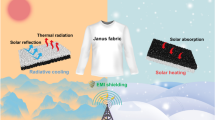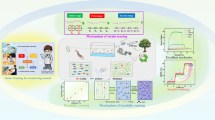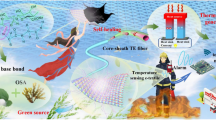Abstract
Affected by thermophysical parameters and basic fabric parameters, thermal protection, thermal and moisture comfort and wearability of thermal protective clothing present opposite representation. To balance the contradiction, a hollow structure is proposed for thermal barrier, including covered skin, cavity and pillar. This three-layer structure is formed by middle layer composed of cavity and pillar wrapped by covered skin upper and lower. The whole structure is composed of fibers, and cavity and pillar with different bulk density is evenly distributed in meddle layer. This hollow structure can be obtained by pretreating, needle punching, washing and drying of polyvinyl alcohol/thermal materials composite felt due to the characteristic of water-soluble of polyvinyl alcohol. Through the preparation and comprehensive evaluation of hollow structure thermal barrier, it is found that hollow structure thermal barrier proposed has higher TPP value, lower moisture resistance, higher air permeability and higher softness compared with solid structure. Meanwhile, quality evaluation index of hollow structure is improved through the hierarchical evaluation model, which has a guiding and reference significance for the development of hollow thermal protective fabrics.








Similar content being viewed by others
Data Availability
The authors confirm that the data supporting the findings of this study are available within the article [and/or its supplementary materials].
References
P. Bajaj, A.K. Sengupta, Text. Prog. 22, 1 (1992)
R.L. Barker, A.S. Deaton, K.A. Ross, Fire Technol. 47, 549 (2011)
I. Shalev, R.L. Barker, Text. Res. J. 53, 475 (1983)
R.B. Ma, Prog. Org. Coat. 131, 100 (2019)
M. Venkataraman, R. Mishra, T.M. Kotresh, J. Militky, H. Jamshaid, Text. Prog. 48, 55 (2016)
L. **, K. J. Yoon, and Y. Li, Textile Bioengineering and Informatics Symposium Proceedings. Textile Bioengineering & Informatics Society Ltd, Hong Kong Sar. 1–3:565–570. (2013).
M. Venkataraman, R. Mishra, J. Wiener, J. Militky, T.M. Kotresh, M. Vaclavik, J. Text. Inst. Proc. & Abstr. 106, 736 (2015)
D. Huang, C. Guo, Mater. Sci. 23, 335 (2017)
H.Y. Li, W.Y. Zhang, J. Text. Res. 29, 84 (2008)
X.N. Hou, H. Hu, V.V. Silberschmidt, J. Mater. Sci. 47, 3989 (2012)
Y. Liu, H. Hu, Int. J. Mech. Sci. 94, 244 (2015)
B. W. Hendrickson, M.D. Dissertation, UMD, Maryland, 2011.
D. A. Yates, M.D. Dissertation, UMD, Maryland, 2012.
S. Yoo, J. Yeo, S. Hwang, Y.H. Kim, S.G. Hur, E. Kim, Mater. Sci. Eng. A 481, 662 (2008)
J. P. White, M.D. Dissertation, UMD, Maryland, 2012.
S. Wang, Y.H. Lu, L.Y. Wang, S.Y. You, J. Text. Res. 39, 113 (2017)
F.F. Du, X.H. Li, J. Ind. Text. 50, 1 (2019)
A. Shaid, M. Furgusson, L. Wang, Chem. & Mater. Eng. 2, 37 (2014)
S. H. Eryuruk, H. Gidik, V. Koncar, F. Kalaoglu, and Y. Saglam, J. Ind. Text. 51, 3 (2022)
H. Zhang, G.W. Song, H. Su, H.T. Ren, J. Cao, Fire & Mater. 41, 953 (2017)
M. Tian, Q. Wan, Y. **ao, Y. Su, J. Li. Mater. 13, 3579 (2020)
D. Zhao, X. Lu, T. Fan, Y.S. Wu, L. Lou, Q. Wang, J. Fan, R. Yang, Appl. Energy 218, 282 (2018)
L. Lou, K. Chen, J. Fan. Mater. Sci. Eng. 146, 100639 (2021)
X. **ong, T. Yang, R. Mishra, H. Kanai, J. Militky, J. Ind. Text. 47, 1998 (2018)
S. Yu, M.C. Dong, G.M. Jiang, P.B. Ma, Compos. Struct. 256, 1 (2020)
S.S. Woo, I. Shalev, R.L. Barker, Text. Res. J. 64, 149 (1994)
G. Zhu, D. Kremenakova, Y. Wang, J. Militky, R. Mishra, Ind. Text. 66, 74 (2015)
G.W. Song, S. Paskaluk, R. Sati, E.M. Crown, J.D. Dale, M. Ackerman, Text. Res. J. 81, 311 (2010)
F. F. Du, M.D. Dissertation, DHU, Donghua, 2020.
X.G. Yin, X.W. Guan, L. Chen, H.M. Sun, F. Wei, M.C. Dou, Fire Sci. Technol. 35, 1736 (2016)
S.N. Zhai, T.Q. Chen, C.Y. Jiang, J.J. Fu, H.B. Wang, J. Text. Res. 39, 100 (2018)
Acknowledgements
We would like to acknowledge the financial support from the Fundamental Research Funds for the Central Universities [No.2232022G-08] and the National Natural Science Foundation of China under Grant [No. 51703026].
Author information
Authors and Affiliations
Corresponding author
Ethics declarations
Conflict of Interest
We declare that we have no conflict of interest to this work.
Rights and permissions
Springer Nature or its licensor (e.g. a society or other partner) holds exclusive rights to this article under a publishing agreement with the author(s) or other rightsholder(s); author self-archiving of the accepted manuscript version of this article is solely governed by the terms of such publishing agreement and applicable law.
About this article
Cite this article
Dai, J., Zhang, Y. & Li, X. A Hollow Structure of Thermal Barrier for Thermal Protective Clothing. Fibers Polym 25, 713–724 (2024). https://doi.org/10.1007/s12221-023-00464-6
Received:
Revised:
Accepted:
Published:
Issue Date:
DOI: https://doi.org/10.1007/s12221-023-00464-6




